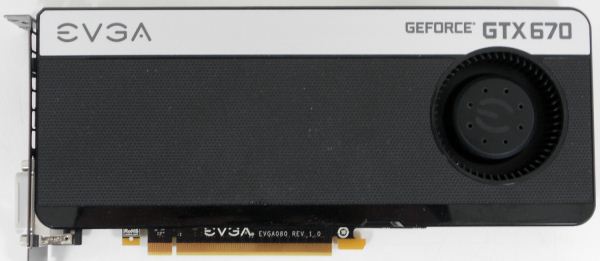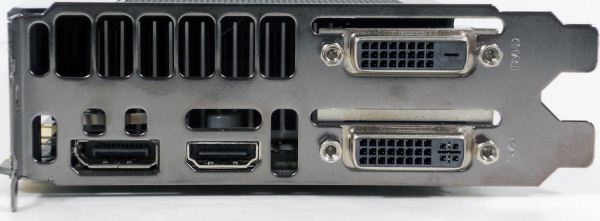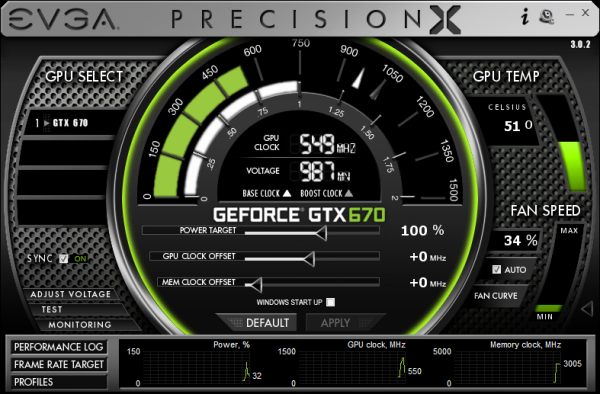NVIDIA GeForce GTX 670 Review Feat. EVGA: Bringing GK104 Down To $400
by Ryan Smith on May 10, 2012 9:00 AM ESTMeet The EVGA GeForce GTX 670 Superclocked
Our second card of the day is EVGA’s GeForce GTX 670 Superclocked, which in EVGA’s hierarchy is their first tier of factory overclocked cards. EVGA is binning GTX 670s and in turn promoting some of them to this tier, which means the GTX 670 Superclocked are equipped with generally better performing chips than the average reference card.
| GeForce GTX 670 Partner Card Specification Comparison | ||||
| EVGA GeForce GTX 670 Superclocked | GeForce GTX 670 (Ref) | |||
| CUDA Cores | 1344 | 1344 | ||
| Texture Units | 112 | 112 | ||
| ROPs | 32 | 32 | ||
| Base Clock | 967MHz | 915MHz | ||
| Boost Clock | 1046MHz | 980MHz | ||
| Memory Clock | 6210MHz | 6008MHz | ||
| Memory Bus Width | 256-bit | 256-bit | ||
| Frame Buffer | 2GB | 2GB | ||
| TDP | 170W | 170W | ||
| Manufacturing Process | TSMC 28nm | TSMC 28nm | ||
| Width | Double Slot | Double Slot | ||
| Length | 9.5" | 9.5" | ||
| Warranty | 3 Years | N/A | ||
| Price Point | $419 | $399 | ||
For the GTX 670 SC, EVGA has given both the core clock and memory clock a moderate boost. The core clock has been increased by 52MHz (6%) to 967MHz base and 66MHz (7%) boost to 1046MHz. Meanwhile the memory clock has been increased by 202MHz (3%) to 6210MHz.
Other than the clockspeed changes, the GTX 670 SC is an almost-reference card utilizing a reference PCB with a slightly modified cooler. EVGA is fabricating their own shroud, but they’ve copied NVIDIA’s reference shroud down to almost the last detail. The only functional difference is that the diameter of the fan intake is about 5mm less, otherwise the only difference is that EVGA has detailed it differently than NVIDIA and used some rounded corners in place of square corners.
The only other change you’ll notice is that EVGA is using their own high flow bracket in place of NVIDIA’s bracket. The high flow bracket cuts away as much metal as possible, maximizing the area of the vents. Though based on our power and temperature readings, this doesn’t seem to have notably impacted the GTX 670 SC.
While we’re on the matter of customized cards and factory overclocks, it’s worth reiterating NVIDIA’s position on factory overclocked cards. Reference and semi-custom cards (that is, cards using the reference PCB) must adhere to NVIDIA’s power target limits. For GTX 670 this is a 141W power target, with a maximum power target of 122% (170W). Fully custom cards with better power delivery circuitry can go higher, but not semi-custom cards. As a result the flexibility in building semi-custom cards comes down to binning. EVGA can bin better chips and use them in cards such as the Superclocked – such as our sample which can go 17 boost bins over the base clock versus 13 bins for our reference GTX 670 – but at the end of the day for stock performance they’re at the mercy of what can be accomplished within 141W/170W.
In any case, as the card is otherwise a reference GTX 670 EVGA is relying on the combination of their factory overclock, their toolset, and their strong reputation for support to carry the card. EVGA has priced the card at $419, $20 over the GTX 670 MSRP, in-line with other factory overclocked cards.
On the subject of pricing and warranties, since this is the first EVGA card we’ve reviewed since April 1st, this is a good time to go over the recent warranty changes EVGA has made.
Starting April 1st, EVGA has implemented what they’re calling their new Global Warranty Policy. Starting July 1st, 2011 (the policy is being backdated), all new EVGA cards ship with at least a 3 year warranty. And for the GTX 600 series specifically, so far EVGA has only offered models with a 3 year warranty in North America, which simplifies their product lineup.
To complement the 3 year warranty and replace the lack of longer term warranties, EVGA is now directly selling 2 and 7 year warranty extensions, for a total of 5 and 10 years respectively. So instead of buying a card with a 3 year warranty or a longer warranty, you’ll simply buy the 3 year card and then buy a warranty extension to go with it. However the extended warranty requires that the card be registered and the warranty purchased within 30 days.
The second change is that the base 3 year warranty no longer requires product registration. EVGA has other ways to entice buyers into registering, but they’ll now honor all applicable cards for 3 years regardless of the registration status. At the same time the base 3 year warranty is now a per-product warranty (e.g. a transferable warranty) rather than per-user warranty, so the base warranty will transfer to 2nd hand buyers. The extended warranties however will not.
The third change is how EVGA is actually going to handle the warranty process. First and foremost, EVGA is now allowing cards to be sent to the nearest EVGA RMA office rather than the office for the region the card was purchased from. For example a buyer moving from Europe to North America can send the card to EVGA’s North American offices rather than sending it overseas.
Finally, EVGA is now doing free cross shipping, alongside their existing Advanced RMA program. EVGA will now cross-ship replacement cards for free to buyers. The buyer meanwhile is responsible for paying to ship the faulty card back and putting up collateral on the new card until EVGA receives the old card.
There’s also one quick change to the step-up program that will impact some customers. With the move to purchasing extended warranties, the step-up program is only available to customers who either purchase an extended warranty or purchase an older generation card that comes with a lifetime warranty. Step-up is not available to cards with only the base 3 year warranty.
Moving on, along with EVGA’s new warranty EVGA is bundling the latest version of their GPU utilities, Precision X and OC Scanner X.
Precision X, as we touched upon quickly in our GTX 680 review, is the latest iteration of EVGA’s Precision overclocking & monitoring utility. It’s still based on RivaTuner and along with adding support for the GTX 600 series features (power targets, framerate caps, etc), it also introduces a new UI. Functionality wise it’s still at the top of the pack along with the similarly RivaTuner powered MSI Afterburner. Personally I’m not a fan of the new UI – circular UIs and sliders aren’t particularly easy to read – but it gets the job done.
OC Scanner X has also received a facelift and functionality upgrade of its own. Along with its basic FurMark-ish stress testing and error checking, it now also offers a basic CPU stress test and GPU benchmark.



















414 Comments
View All Comments
CeriseCogburn - Friday, May 11, 2012 - link
The talking point amd fanboys have a real problem. On their suddenly favorite gaming benchmark, Crysis warhead, the entire brand new line of cards is DEAD above 1920 in this very review.They are all toast at 1920X1200 - nothing above will do, all that fancy 3G ram is absolutely zero @ 2560 in their mostest favorite 4 year old benchmark - and has full on competition at the only playable framerate in their one of two current wins, the second win - Metro2003 barely hanging on by a thread and on some reviews the 7970 loses it due to different eye candy settings- and let me not be so irresponsible as they and the reviewer are, and point out, the Metro2033 bench results in this very article leave the only playable resolution presented - yep you guessed it - 1920X1200, the lowest resolution presented.
Above that even the purported 7970 winner is absolute unplayable crap at 2560 - memory and all.
Now, that's the end of another important lesson, the core puke of the 7970 on both of the amd fanboys now instantly favorite games at the lowest of 3 resolutions presented, 3G ram worth absolutely nothing, less than nothing.
The immense blindness of the amd fanboys reaches the outer limits of the twilight zone.
CeriseCogburn - Friday, May 11, 2012 - link
680 is faster at 5760X1080 than 7970, when both are overlcocked." We wanted to be able to run at the native resolution of 5760x1200 and compare the performance to the Radeon HD 7970. We figured if any resolution is going to show the advantages of AMD's memory capacity and memory bandwidth edge it would be 5760x1200. We were absolutely surprised that the GeForce GTX 680 had no trouble keeping pace with the Radeon HD 7970 at 5760x1200. We thought this is the resolution we might see the GTX 680 bottleneck, but to our surprise no bottlenecks were experienced. "
Sorry @ 5670X1080 even overclocked the 7970 loses, and often loses by a lot.
http://www.techpowerup.com/reviews/NVIDIA/GeForce_...
http://www.hardocp.com/article/2012/03/22/nvidia_k...
LOL - nighty nite 7970.
http://www.hardocp.com/article/2012/03/22/nvidia_k...
http://www.hardocp.com/article/2012/03/22/nvidia_k...
CeriseCogburn - Friday, May 11, 2012 - link
" We brought you performance numbers on a 5760x1080 2D panel setup and showed you that that the NVIDIA GeForceGTX 680 had no problems hanging with the fastest factory overclocked AMD Radeon HD 7970 that money can buy
(The MSI R7970 Lightning is $100 more!). If you are looking for a graphics card for a triple-monitor setup today, we have no reservations recommending the NVIDIA GeForce GTX 680! "
LOL - uh huh. 680 stock vs the highest OC 7970 - 680 wins.
http://www.legitreviews.com/article/1887/11/
Pantsu - Friday, May 11, 2012 - link
I applaud your fervor for defending the green team, but I tend to look things a bit less biased.http://techreport.com/articles.x/22922
While the difference between 680 and 7970 stock isn't all that big even on 5760x1080, 7970 does OC and scale in games further than 680, and provides better min fps in situations where 680 memory bandwidth isn't up to snuff. But that's fairly irrelevant, since I can buy a 7970 for ~400€ while 680 is currently unavailable at ~500€.
CeriseCogburn - Friday, May 11, 2012 - link
Not even in at page with your link, but I guess Tech Report is the only one you can't even quote, and we'll just rely on your stupid talking point with zero proof, heck your words do it - your words. ROFL.No need to admire someone who is surrounded by so many liars. No need to defend nVidia, how about having one oyu lousy liars actually have even a shred of evidence ?
So far, none of you have it. Not that it matters, you're all amd fanboys anyway so facts don't matter.
CeriseCogburn - Friday, May 11, 2012 - link
LOL - from your link " The 670 trails its big brother, the GeForce GTX 680, by only an eyelash in most of our performance results, closely enough that you'd have a very hard time telling the difference between them in everyday use. Not only that, but it delivers lower 99th percentile frame times than both the Radeon HD 7950 and the 7970 in three of our four game tests. Meanwhile, the 670's power consumption is quite tame.If I were buying a video card right now for myself, I'd order up a GeForce GTX 670. You really can drive three two-megapixel displays with it and play games at reasonable frame rates, even though you'd want to go easier on the image quality options than we did. For those folks with a four-megapixel display or less, the 670 should deliver a nice dose of gaming nirvana. Now that the 670 is here, I fail to see the point of spending more on a GeForce GTX 680 or a Radeon HD 7970"
Why do you amd fans lie so much ?
CeriseCogburn - Friday, May 11, 2012 - link
Let's talk about your type of rampant fanboyism - not a songel OC 7970 at yuor link for Tech Report - but you know what - here's a dual OC link 680 and 7970 OC, and in the chart they have a TIE 3/3 wins each, but we look further and in Batman, they excuse the amd since it can do PhysX, that makes it 4 to 3, and in TWS2, they have the amd card winning, because of the Gaming Evolved game patch that broke nVidia temporarily.That makes it 5 to2 in nVidia's favor.
You get F1 2011, a game even I'd say amd wins in. You get SWTOR, and that's it.
nVidia takes Skyrim, Wow, and Mass Effect 3, adding a +2 to their wins here in other games.
I a sorry, but you amd fanboys actually need to prove your endlessly spewed talking points, and none of you have, in fact you've been proven wrong time and again.
Worse yet, you have big time driver problems, and bigger time lack of features, old, and now many new.
You go buy a 7970, go ahead, but don't feed me your BS or your fake links and expect me to just cave into your lies.
\
FURTHER - here is the GTX680 where you are for 399.99, you even lied about that
http://www.idealo.co.uk/compare/3243808/pny-geforc...
ROFL - so sorry, so many of you, so little honor
CeriseCogburn - Friday, May 11, 2012 - link
Here's the link I promisedhttp://www.hardwareheaven.com/reviews/1455/pg21/as...
Pantsu - Friday, May 11, 2012 - link
http://www.hardware.fr/articles/866-20/recapitulat...There's another link for you where 7970 actually beats 680 at 1920x1080.
Your UK price is in pounds sterling you know, how stupid can you be? Seriously, what on earth is your problem?
CeriseCogburn - Saturday, May 12, 2012 - link
That's a game result, in a foreign language, apparently stupidity is contagious...Let's take the translated conclusion, and see if you're full of it.
" Note that the trend was reversed between the GeForce GTX 680 and Radeon HD 7970, in favor of the latter, mainly for two reasons:
- AMD finally fixed (after 5 months!) A performance problem in Batman AC with MSAA.
- Nvidia suffers from a performance problem in the latest version of Shogun Total War 2."
ROFL - 5 months of failure, and a GAMING EVOLVED amd gaming update hack that disables nVidia cards.... how shameful for the evil amd to do in their gaming evolved sponsored game.
So, no news there, one's a cheat, the others a 5 month lose with a driver fix finally delivered by amd - the other 80% of games go to the nVidia cards, at higher rated percentages of win.
Not certain why you people are so stupid, actually. It certainly isn't what you initially claimed, no overclocked 7970 winning, you've still got nothing.
Goofy amd boys.